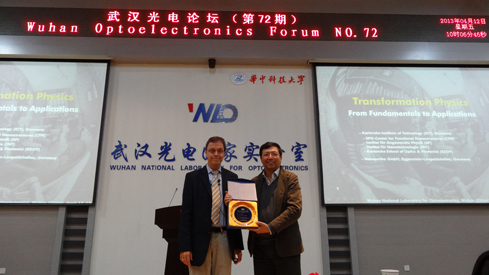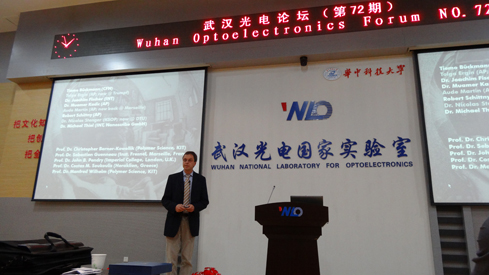WUHAN, China (April 12, 2013) - Wuhan Optoelectronics Forum No. 72 was successfully held in Auditorium A101 at Wuhan National Laboratory for Optoelectronics (WNLO) in the morning of April 12.
Transformation optics allows for mapping the geometry of space onto spatially inhomogeneous optical properties of metamaterials. Invisibility cloaks are a demanding benchmark example because they were believed impossible just a few years ago. For the fabrication of visible-frequency, broadband, polarization-independent, three-dimensional invisibility cloaks for the amplitude and phase of light, we use direct-laser-writing (DLW) optical lithography combined with stimulated-emission depletion (STED), which breaks Abbe’s diffraction limit. The transformation idea can also be translated to other areas such as mechanics (precisely, elastodynamics) and thermodynamics. Corresponding experiments will be discussed, too.
After completing his PhD in physics in 1987 at Johann Wolfgang Goethe-Universität Frankfurt (Germany), he spent two years as a postdoc at AT&T Bell Laboratories in Holmdel (U.S.A.). From 1990-1995 he was C3-Professor at Universität Dortmund (Germany), since 1995 he is C4-Professor at Universität Karlsruhe (TH). Since 2001 he has a joint appointment at Institut für Nanotechnologie of Forschungszentrum Karlsruhe GmbH. Since 2001 he is also the coordinator of the DFG-Center for Functional Nanostructures (CFN) in Karlsruhe. His research interests comprise ultrafast optics, (extreme) nonlinear optics, near-field optics, photonic crystals, photonic metamaterials, and transformation optics. This research has led to various awards and honors, among which are the Alfried Krupp von Bohlen und Halbach Research Award 1993, the Baden-Württemberg Teaching Award 1998, the DFG Gottfried Wilhelm Leibniz Award 2000, the European Union René Descartes Prize 2005, the Baden-Württemberg Research Award 2005, and the Carl Zeiss Research Award 2006. He is a member of Leopoldina, the German Academy of Sciences (since 2006), Fellow of the Optical Society of America (since 2008), Fellow of the Hector Foundation (since 2008), and Adjunct Professor at the Optical Sciences Center, Tucson, U.S.A. (since 2009).

